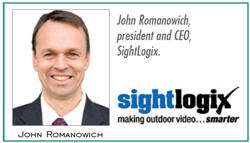Want To Expand Your Video Surveillance Business? Step Outside.
By Brian Albright, Business Solutions Magazine
Thermal cameras open up lucrative opportunities in outdoor surveillance applications.
Thermal cameras, upgraded processing capabilities, and networked surveillance technology are creating opportunities for security and surveillance resellers in outdoor applications. Thermal image cameras use heat to create images, which means they do not suffer from the illumination restrictions of traditional cameras. “This capability for thermal cameras to work during the daytime didn’t exist a few years ago,” says John Romanowich, president and CEO of SightLogix. “New imager sensitivity and greater processing power at the edge has made this a round-the-clock solution, and it’s unlocking a new market opportunity for VARs.”
 Potential markets for the technology include facility and asset monitoring in the energy, petroleum, and transportation markets, among others. “The prior approach for those applications was to use a fence sensor or volumetric sensor to identify activity, which would then be augmented with a camera to determine the cause of the alert,” Romanowich says. “Those systems were woefully ineffective because the sensors would generate nuisance alerts, and they were costly because two systems were involved, a sensor system and a video system. Thermal cameras with analytics combine these two systems into one and eliminate issues associated with nuisance alerts.”
Potential markets for the technology include facility and asset monitoring in the energy, petroleum, and transportation markets, among others. “The prior approach for those applications was to use a fence sensor or volumetric sensor to identify activity, which would then be augmented with a camera to determine the cause of the alert,” Romanowich says. “Those systems were woefully ineffective because the sensors would generate nuisance alerts, and they were costly because two systems were involved, a sensor system and a video system. Thermal cameras with analytics combine these two systems into one and eliminate issues associated with nuisance alerts.”
The combination of analytics and enhanced imagery allows the surveillance system to detect activity and determine when an alert is accurate (i.e., distinguishing between a human tripping a sensor versus an animal). Price points for this technology are now falling to a level where they are competitive with older, less-effective solutions, and they don’t require much specialized training. “Any competent technical person can learn the fundamentals in a few hours and go on to install the cameras to create an accurate security solution,” Romanowich says.
New Applications Enabled By Improved Camera Technology
As in indoor environments, outdoor surveillance solutions can provide video data to fuel other types of applications. For instance, with a thermal camera a company could determine if there is a leak at a refinery, or if transformers are overheating at a power station. The cameras can also monitor storage tank levels.
“You can determine the occupancy of a truck stop, the volume of traffic in a road, and even whether a car is driving the wrong way on a highway,” Romanowich says. “It opens up a whole new world of understanding about what is happening outdoors, from early detection scenarios to looking at behavior that could increase operational efficiency.”
One critical part of selling an outdoor surveillance solution is the infrastructure requirements. “If you are selling cameras for indoor use, you don’t have to worry about the infrastructure,” Romanowich says. “Outdoors, it’s a key component of serving the customer. You may have to do trenching or put up poles, and it’s a whole different level of design and analysis.” Look for opportunities to use solar power and wireless communication to minimize the additional power and networking infrastructure requirements, or use cameras that have longer ranges to minimize the need for additional mounting poles.
Building competence in a vertical allows you to assist customers with specific compliance requirements. That way, you can help a broad base of clients with specific requirements who may want to unilaterally outsource some of those surveillance functions. Since many of the markets looking for robust outdoor surveillance systems are large, often multi-national operators, they can open the door for lucrative, ongoing business at multiple locations. “This provides the opportunity for a VAR to be a big player outdoors,” Romanowich says. “There are some large opportunities that dwarf the ones that exist for indoor applications.”
“Really clever VARs are moving toward becoming a trusted partner to help big end users grow their business,” Romanowich says. “As you start to help big end users solve big problems, they will be very interested in scaling that across the globe. If you find an opportunity with an energy company, you might find it is a distributed problem. If you make that customer very happy in their Houston facility, you could very well follow them around the world addressing the same application.”
